Improvement of the Numerical Tropical Cyclone Prediction System at the Central Weather Bureau of Taiwan: TWRF (Typhoon WRF)
Abstract
1. Introduction
2. Configuration of the TWRF
3. Performance Comparison between TWRF V1 and V2
3.1. Comparison of Track and Intensity Predictions
3.2. Comparison of Synoptic-Scale Forecast
3.3. Case Studies
4. Summary and Future Plan
- With identical computing domains, 15-km V2D1 reduced 16.6% of track errors and 50% of intensity errors in 45-km V1D1 at an 84-h forecast, robustly proving that employing the finer grid improved the TC forecast. In nested domains, the reduction of intensity errors was agreeing with increasing model resolution. However, the track forecast between different model resolutions was comparable, which might result from their limited domain size. Besides, the 3-km mesh had the smallest intensity errors in the initial condition, implying the benefits of high-resolution model integration under the partial cycle strategy.
- Apart from in-house evaluation, the comparison with the leading global models suggested that TWRF V2 has competitive forecast skill. Due to the coarser grid, 15-km V2D1 has a larger intensity errors and comparable track errors with the 13-km NCEP and 9-km ECMWF global models. With the finer grid compared with the above two global models, 3-km V2D2 had the smallest intensity bias. Furthermore, its 72-h track prediction skill was comparable to ECMWF and better than NCEP.
- Case studies clearly identified the improvement of TC track, intensity, and the TC inner core structure in the high-resolution model. Further, the complex terrain in Taiwan was resolved with more details in the finer grid. As a consequence of this progress, the high-resolution model captured the terrain phase-lock effect, and therefore improved the TC quantitative precipitation forecast skill over the complex terrain.
Author Contributions
Funding
Acknowledgments
Conflicts of Interest
References
- Wu, C.-C.; Kuo, Y.-H. Typhoons Affecting Taiwan: Current Understanding and Future Challenges. Bull. Am. Meteorol. Soc. 1999, 80, 67–80. [Google Scholar] [CrossRef]
- DeMaria, M.; Knaff, J.; Sampson, C. Evaluation of long-term trends in tropical cyclone intensity forecasts. Theor. Appl. Clim. 2007, 97, 19–28. [Google Scholar] [CrossRef]
- DeMaria, M.; Sampson, C.R.; Knaff, J.; Musgrave, K.D. Is Tropical Cyclone Intensity Guidance Improving? Bull. Am. Meteorol. Soc. 2014, 95, 387–398. [Google Scholar] [CrossRef]
- Skamarock, W.C.; Klemp, J.B.; Dudhia, J.; Gil, D.A.; Barker, D.M.; Duda, M.G.; Huang, X.Y.; Wang, W.; Powers, J.G. Description of the Advanced Research WRF Version 3; National Center for Atmospheric Research: Boulder, CO, USA, 2008.
- Hsiao, L.-F.; Liou, C.-S.; Yeh, T.-C.; Guo, Y.-R.; Chen, D.-S.; Huang, K.-N.; Terng, C.-T.; Chen, J.-H. A Vortex Relocation Scheme for Tropical Cyclone Initialization in Advanced Research WRF. Mon. Weather Rev. 2010, 138, 3298–3315. [Google Scholar] [CrossRef]
- Hsiao, L.-F.; Chen, D.-S.; Kuo, Y.-H.; Guo, Y.-R.; Yeh, T.-C.; Hong, J.-S.; Fong, C.-T.; Lee, C.-S. Application of WRF 3DVAR to Operational Typhoon Prediction in Taiwan: Impact of Outer Loop and Partial Cycling Approaches. Weather Forecast. 2012, 27, 1249–1263. [Google Scholar] [CrossRef]
- Yang, X. Analysis Blending Using a Spatial Filter in Grid-Point Model Coupling; Hirlam Newsletter 48, available from the Hirlam-6 Project, c/o Per Undén; The Royal Netherlands Meteorological Institute: Utrecht, The Netherlands, 2005; pp. 49–55. [Google Scholar]
- Hsiao, L.-F.; Huang, X.-Y.; Kuo, Y.-H.; Chen, D.-S.; Wang, H.; Tsai, C.-C.; Yeh, T.-C.; Hong, J.-S.; Fong, C.-T.; Lee, C.-S. Blending of Global and Regional Analyses with a Spatial Filter: Application to Typhoon Prediction over the Western North Pacific Ocean. Weather Forecast. 2015, 30, 754–770. [Google Scholar] [CrossRef]
- Durand, Y.; Bougeault, P. ‘L’analyse Objective PERIDOT’; Note de travail 193; Direction de la Météorologie Nationale/EERM: Toulouse, France, 1987. [Google Scholar]
- Ajjaji, R.; Issara, S. Introduction de l’analyse CANARI du mode≤globalARPe≤globalARPEGEdans le mode≤e≤a domaine limit’e ALADIN’. Master’s Thesis, Ecole Nationale de la M´et´eorologie, Toulouse, France, 1994. [Google Scholar]
- Feng, J.; Sun, J.; Zhang, Y. A Dynamic Blending Scheme to Mitigate Large-Scale Bias in Regional Models. J. Adv. Model. Earth Syst. 2020, 12, 001754. [Google Scholar] [CrossRef]
- Jin, H.; Peng, M.S.; Jin, Y.; Doyle, J.D. An Evaluation of the Impact of Horizontal Resolution on Tropical Cyclone Predictions Using COAMPS-TC. Weather Forecast. 2014, 29, 252–270. [Google Scholar] [CrossRef]
- Zhang, X.; Quirino, T.; Yeh, K.-S.; Gopalakrishnan, S.; Marks, F.; Goldenberg, S.; Aberson, S. HWRFx: Improving Hurricane Forecasts with High-Resolution Modeling. Comput. Sci. Eng. 2010, 13, 13–21. [Google Scholar] [CrossRef]
- Gopalakrishnan, S.G.; Marks, F.; Zhang, X.; Bao, J.-W.; Yeh, K.-S.; Atlas, R. The Experimental HWRF System: A Study on the Influence of Horizontal Resolution on the Structure and Intensity Changes in Tropical Cyclones Using an Idealized Framework. Mon. Weather Rev. 2011, 139, 1762–1784. [Google Scholar] [CrossRef]
- Gopalakrishnan, S.G.; Goldenberg, S.; Quirino, T.; Zhang, X.; Marks, F.; Yeh, K.-S.; Atlas, R.; Tallapragada, V. Toward Improving High-Resolution Numerical Hurricane Forecasting: Influence of Model Horizontal Grid Resolution, Initialization, and Physics. Weather Forecast. 2012, 27, 647–666. [Google Scholar] [CrossRef]
- Done, J.; Davis, C.A.; Weisman, M. The next generation of NWP: Explicit forecasts of convection using the weather research and forecasting (WRF) model. Atmos. Sci. Lett. 2004, 5, 110–117. [Google Scholar] [CrossRef]
- Schwartz, C.S.; Kain, J.S.; Weiss, S.J.; Xue, M.; Bright, D.R.; Kong, F.; Thomas, K.W.; Levit, J.J.; Coniglio, M.C. Next-Day Convection-Allowing WRF Model Guidance: A Second Look at 2-km versus 4-km Grid Spacing. Mon. Weather Rev. 2009, 137, 3351–3372. [Google Scholar] [CrossRef]
- Tallapragada, V.; Kieu, C.; Kwon, Y.; Trahan, S.; Liu, Q.; Zhang, Z.; Kwon, I.-H. Evaluation of Storm Structure from the Operational HWRF during 2012 Implementation. Mon. Weather Rev. 2014, 142, 4308–4325. [Google Scholar] [CrossRef]
- Tallapragada, V.; Kieu, C.; Trahan, S.; Zhang, Z.; Liu, Q.; Wang, W.; Tong, M.; Zhang, B.; Strahl, B. Forecasting Tropical Cyclones in the Western North Pacific Basin Using the NCEP Operational HWRF: Real-Time Implementation in 2012. Weather Forecast. 2015, 30, 1355–1373. [Google Scholar] [CrossRef]
- Tallapragada, V.; Kieu, C.Q.; Trahan, S.; Liu, Q.; Wang, W.; Zhang, Z.; Tong, M.; Zhang, B.; Zhu, L.; Strahl, B. Forecasting Tropical Cyclones in the Western North Pacific Basin Using the NCEP Operational HWRF Model: Model Upgrades and Evaluation of Real-Time Performance in 2013. Weather Forecast. 2016, 31, 877–894. [Google Scholar] [CrossRef]
- Tao, W.-K.; Simpson, J.; Baker, D.; Braun, S.; Chou, M.-D.; Ferrier, B.; Johnson, D.; Khain, A.; Lang, S.; Lynn, B.; et al. Microphysics, radiation and surface processes in the Goddard Cumulus Ensemble (GCE) model. Theor. Appl. Clim. 2003, 82, 97–137. [Google Scholar] [CrossRef]
- Kain, J.S. The Kain–Fritsch convective parameterization scheme: An update. J. Appl. Meteorol. 2004, 43, 170–181. [Google Scholar] [CrossRef]
- Hong, S.-Y.; Noh, Y.; Dudhia, J. A New Vertical Diffusion Package with an Explicit Treatment of Entrainment Processes. Mon. Weather Rev. 2006, 134, 2318–2341. [Google Scholar] [CrossRef]
- Chen, F.; Dudhia, J. Coupling an advanced land-surface/hydrology model with the Penn State/NCAR MM5 modeling system. Part I: Model description and implementation. Mon. Weather Rev. 2001, 129, 569–585. [Google Scholar] [CrossRef]
- Mlawer, E.J.; Taubman, S.J.; Brown, P.D.; Iacono, M.J.; Clough, S.A. Radiative transfer for inhomogeneous atmospheres: RRTM, a validated correlated-k model for the longwave. J. Geophys. Res. Space Phys. 1997, 102, 16663–16682. [Google Scholar] [CrossRef]
- Iacono, M.J.; Delamere, J.S.; Mlawer, E.J.; Shephard, M.W.; Clough, S.A.; Collins, W. Radiative forcing by long-lived greenhouse gases: Calculations with the AER radiative transfer models. J. Geophys. Res. Space Phys. 2008, 113. [Google Scholar] [CrossRef]
- Wu, C.-C.; Yen, T.-H.; Kuo, Y.-H.; Wang, W. Rainfall Simulation Associated with Typhoon Herb (1996) near Taiwan. Part I: The Topographic Effect. Weather Forecast. 2002, 17, 1001–1015. [Google Scholar] [CrossRef]
- Chien, F.-C.; Kuo, H.-C. On the extreme rainfall of Typhoon Morakot (2009). J. Geophys. Res. Space Phys. 2011, 116. [Google Scholar] [CrossRef]
- Hong, J.-S.; Fong, C.-T.; Hsiao, L.-F.; Yu, Y.-C.; Tzeng, C.-Y. Ensemble Typhoon Quantitative Precipitation Forecasts Model in Taiwan. Weather Forecast. 2015, 30, 217–237. [Google Scholar] [CrossRef]
- Harr, P.A.; Anwender, D.; Jones, S.C. Predictability Associated with the Downstream Impacts of the Extratropical Transition of Tropical Cyclones: Methodology and a Case Study of Typhoon Nabi (2005). Mon. Weather Rev. 2008, 136, 3205–3225. [Google Scholar] [CrossRef]
- Reynolds, C.A.; Peng, M.S.; Chen, J.-H. Recurving Tropical Cyclones: Singular Vector Sensitivity and Downstream Impacts. Mon. Weather Rev. 2009, 137, 1320–1337. [Google Scholar] [CrossRef]
- Fujiwhara, S.; Sekiguchi, K. Estimated 300 m isobars and the weather of Japan. J. Meteorol. Soc. Jpn. 1919, 38, 254–259. (In Japanese) [Google Scholar]
- Brand, S.; Buenafe, C.A.; Hamilton, H.D. Comparison of Tropical Cyclone Motion and Environmental Steering. Mon. Weather Rev. 1981, 109, 908–909. [Google Scholar] [CrossRef][Green Version]
- Zhang, J.; Howard, K.; Chang, P.-L.; Chiu, P.T.-K.; Chen, C.-R.; Langston, C.; Xia, W.; Kaney, B.; Lin, P.-F. High-Resolution QPE System for Taiwan; Springer Science and Business Media LLC: Berlin/Heidelberg, Germany, 2009; pp. 147–162. [Google Scholar]
- Cheung, K.K.; Huang, L.-R.; Lee, C.-S. Characteristics of rainfall during tropical cyclone periods in Taiwan. Nat. Hazards Earth Syst. Sci. 2008, 8, 1463–1474. [Google Scholar] [CrossRef]
- Wu, C.-C.; Cheung, K.K.; Lo, Y.-Y. Numerical Study of the Rainfall Event due to the Interaction of Typhoon Babs (1998) and the Northeasterly Monsoon. Mon. Weather Rev. 2009, 137, 2049–2064. [Google Scholar] [CrossRef]
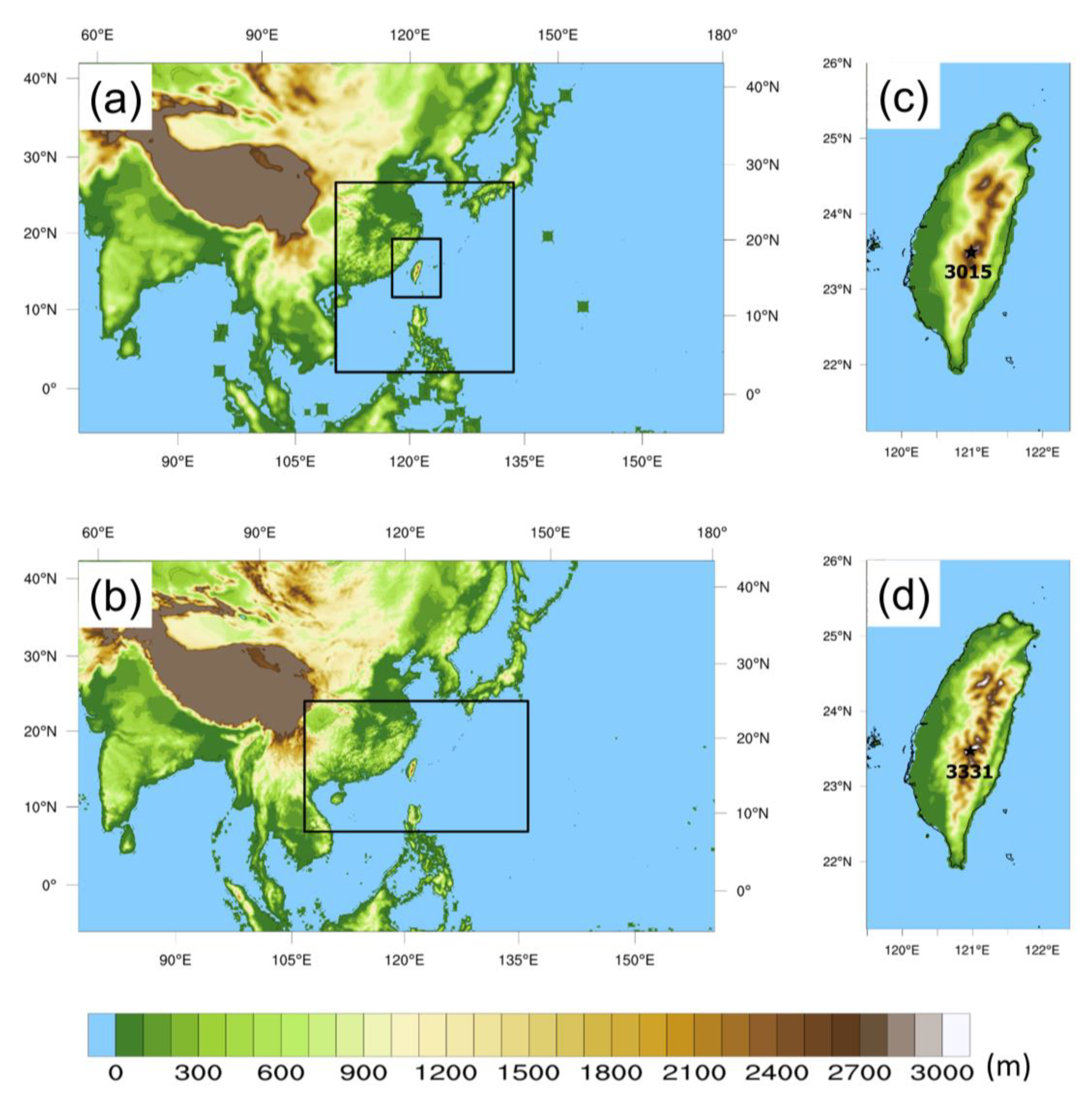
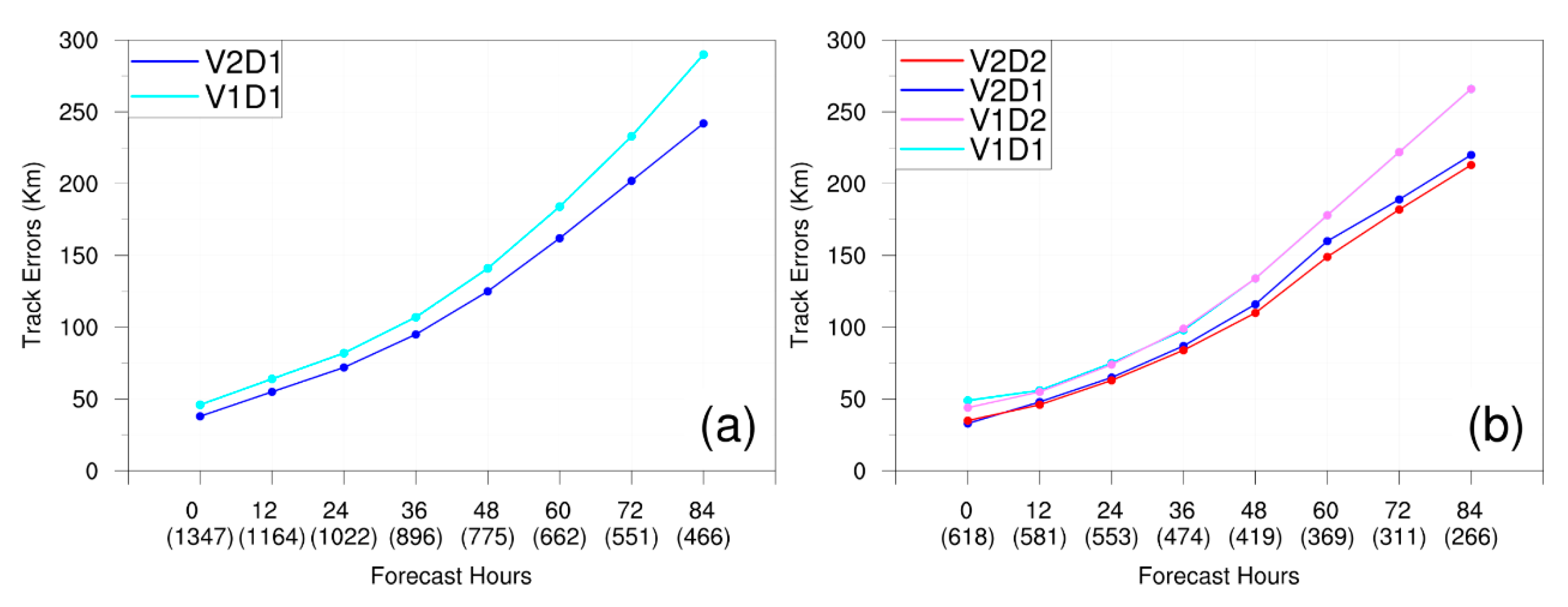

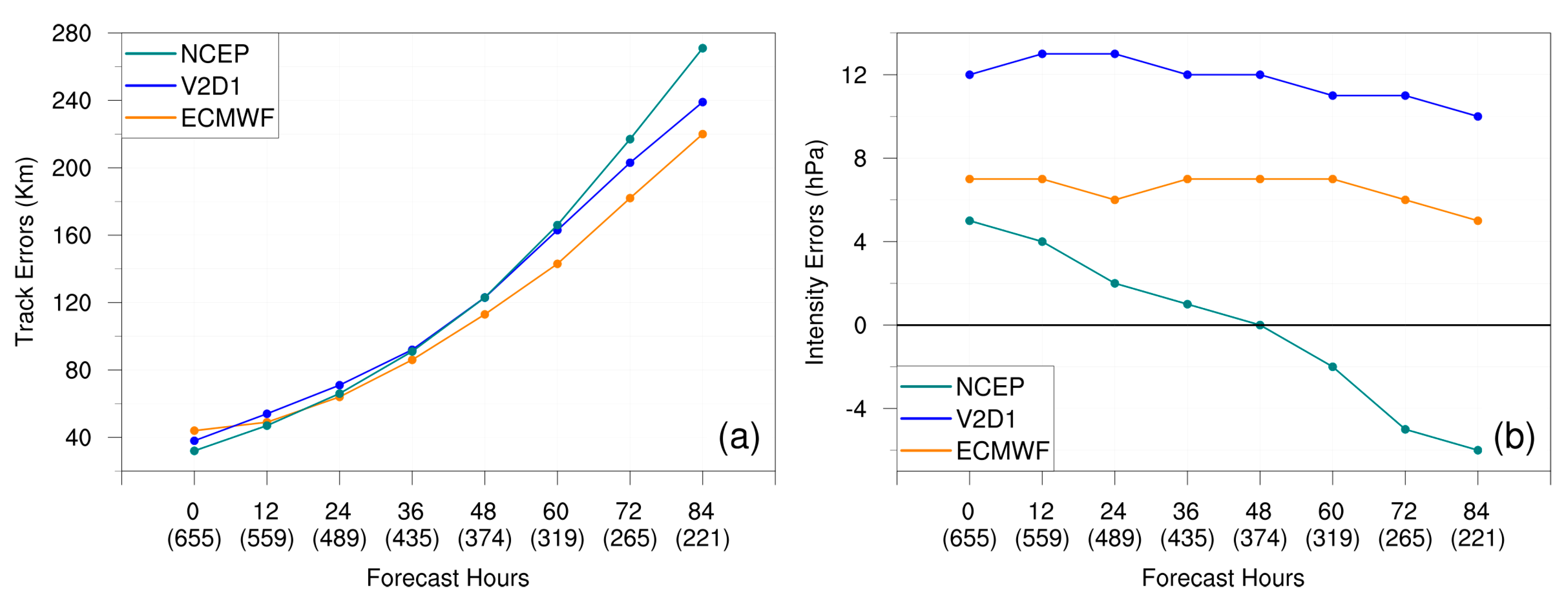
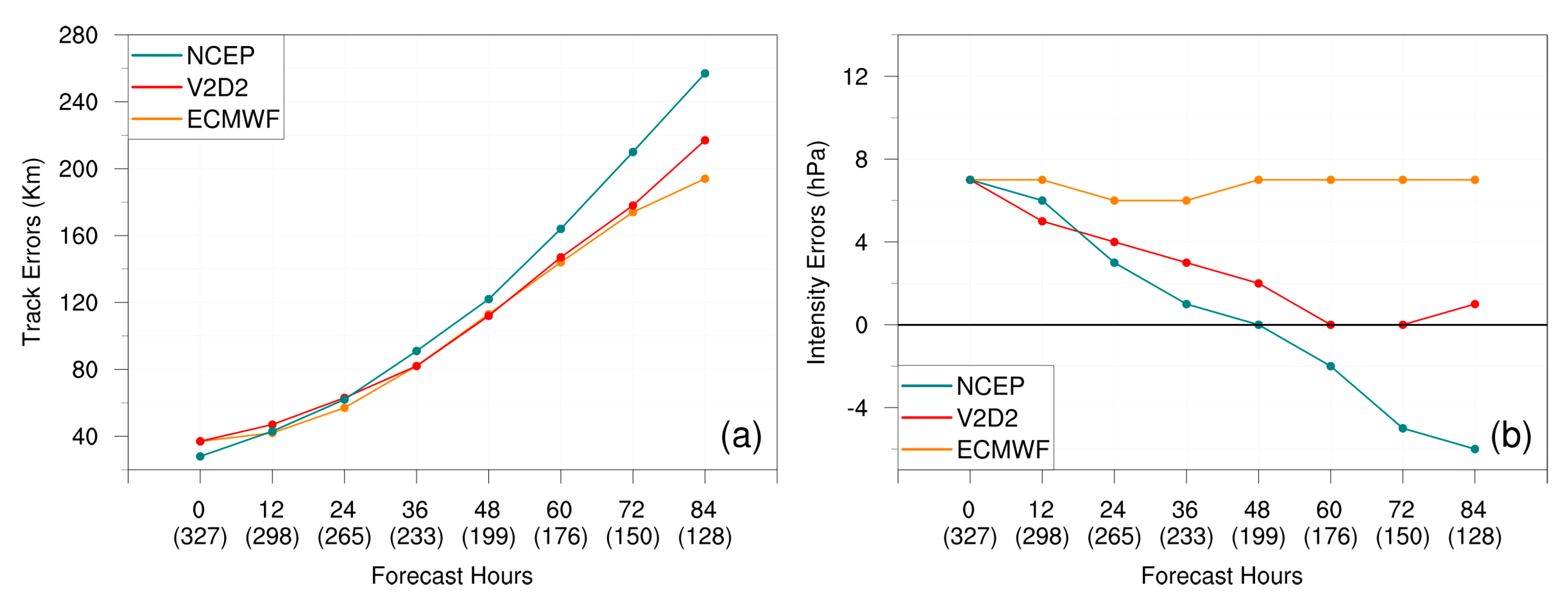
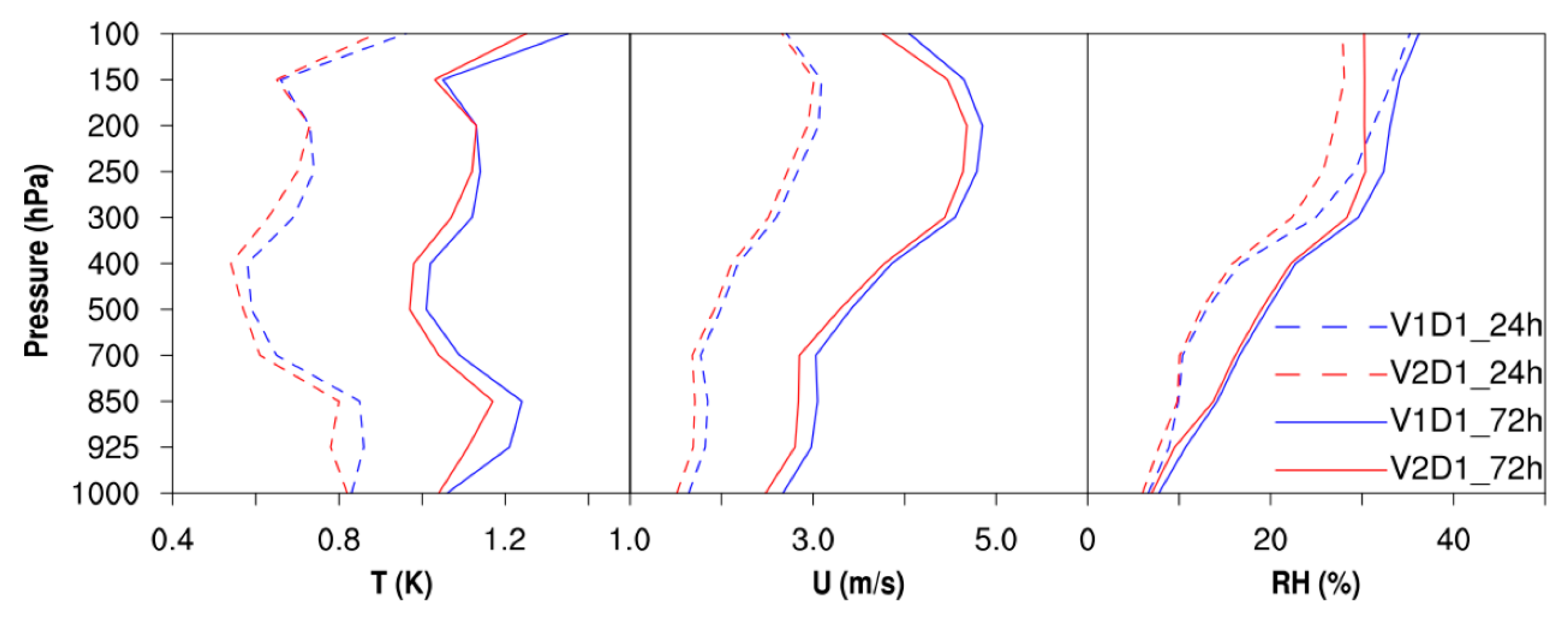
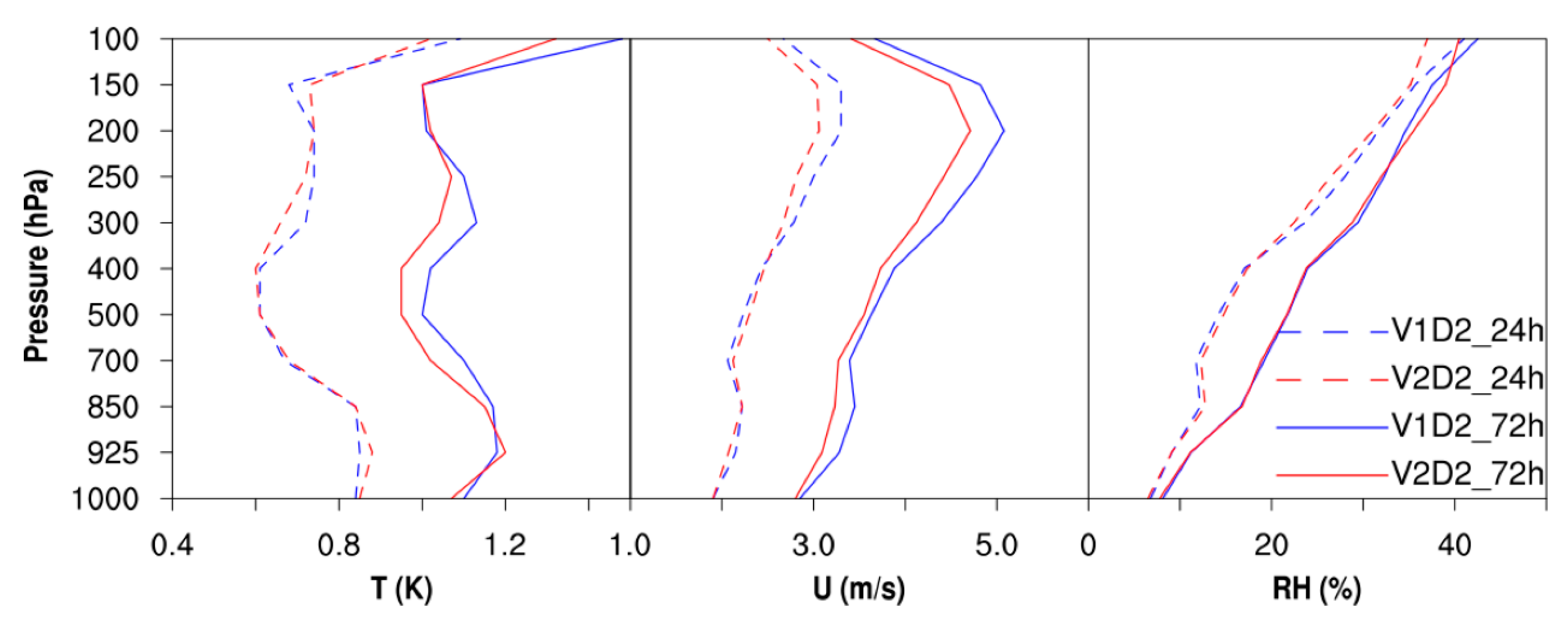


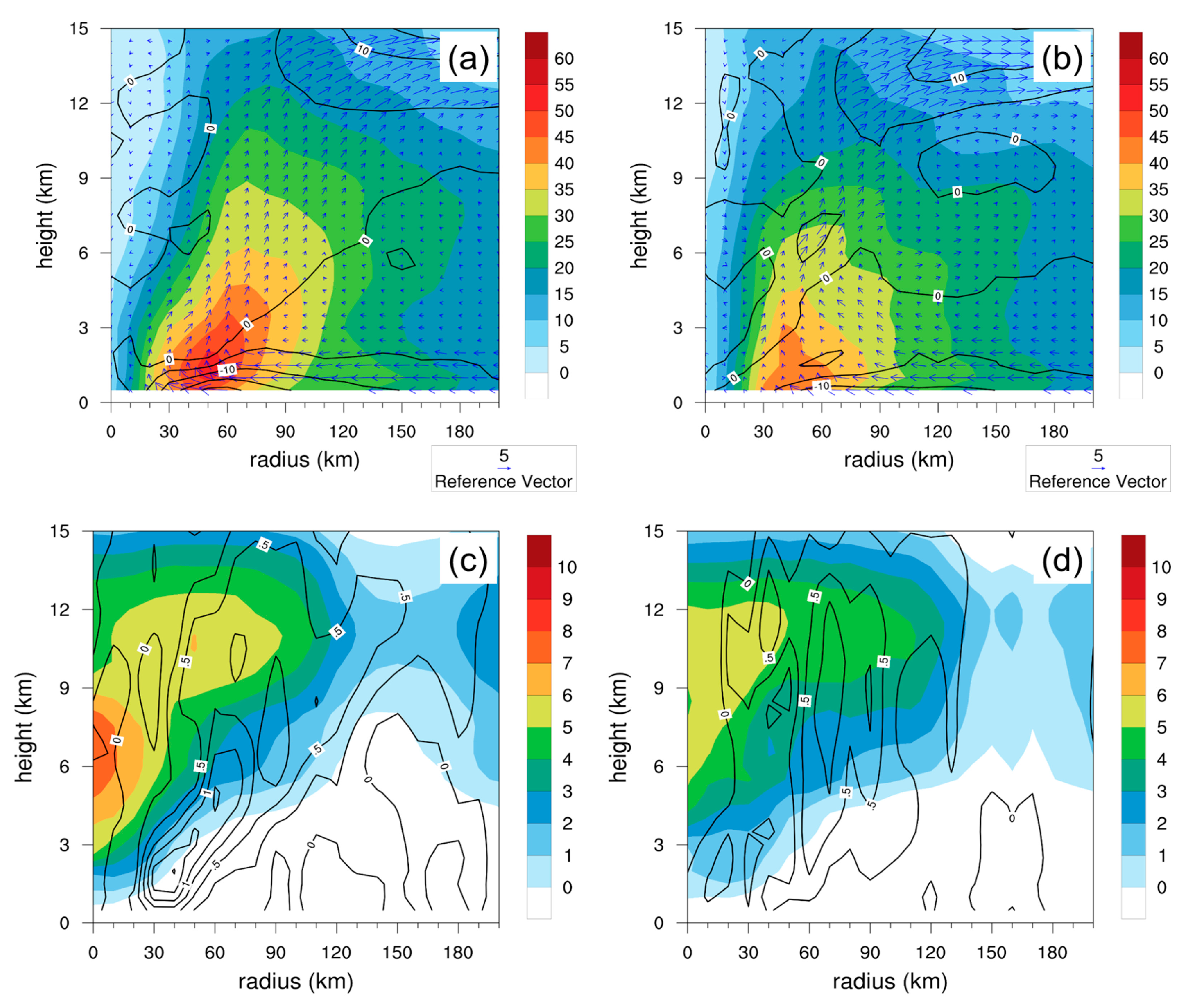
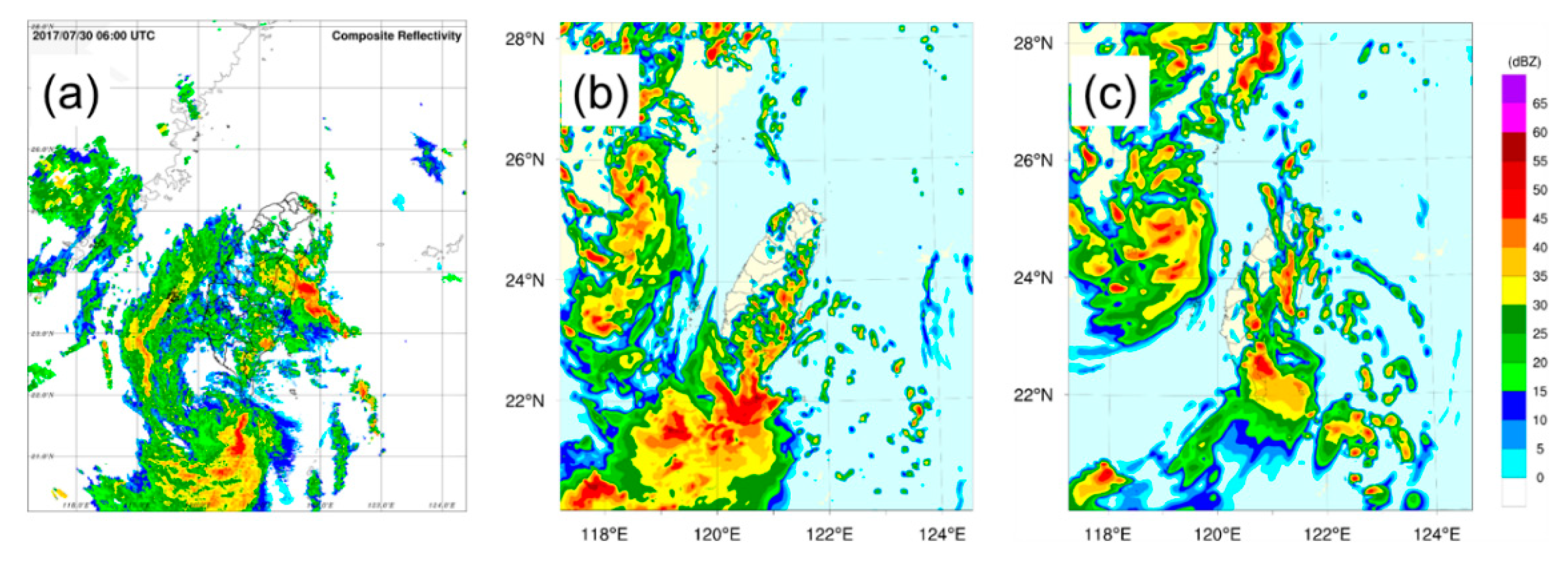



| Designation | TWRF Version | Domain | Resolution |
|---|---|---|---|
| V1D1 | V1 | outer-most domain | 45 km |
| V1D2 | V1 | middle domain | 15 km |
| V1D3 | V1 | inner-most domain | 5 km |
| V2D1 | V2 | outer domain | 15 km |
| V2D2 | V2 | inner domain | 3 km |
© 2020 by the authors. Licensee MDPI, Basel, Switzerland. This article is an open access article distributed under the terms and conditions of the Creative Commons Attribution (CC BY) license (http://creativecommons.org/licenses/by/4.0/).
Share and Cite
Hsiao, L.-F.; Chen, D.-S.; Hong, J.-S.; Yeh, T.-C.; Fong, C.-T. Improvement of the Numerical Tropical Cyclone Prediction System at the Central Weather Bureau of Taiwan: TWRF (Typhoon WRF). Atmosphere 2020, 11, 657. https://doi.org/10.3390/atmos11060657
Hsiao L-F, Chen D-S, Hong J-S, Yeh T-C, Fong C-T. Improvement of the Numerical Tropical Cyclone Prediction System at the Central Weather Bureau of Taiwan: TWRF (Typhoon WRF). Atmosphere. 2020; 11(6):657. https://doi.org/10.3390/atmos11060657
Chicago/Turabian StyleHsiao, Ling-Feng, Der-Song Chen, Jing-Shan Hong, Tien-Chiang Yeh, and Chin-Tzu Fong. 2020. "Improvement of the Numerical Tropical Cyclone Prediction System at the Central Weather Bureau of Taiwan: TWRF (Typhoon WRF)" Atmosphere 11, no. 6: 657. https://doi.org/10.3390/atmos11060657
APA StyleHsiao, L.-F., Chen, D.-S., Hong, J.-S., Yeh, T.-C., & Fong, C.-T. (2020). Improvement of the Numerical Tropical Cyclone Prediction System at the Central Weather Bureau of Taiwan: TWRF (Typhoon WRF). Atmosphere, 11(6), 657. https://doi.org/10.3390/atmos11060657





